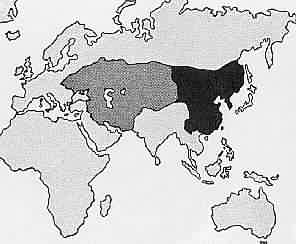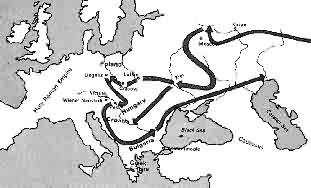
MARCH OF THE TITANS - A HISTORY OF THE WHITE RACE
CHAPTER 32 : THE FIFTH GREAT RACE WAR - GENGHIS KHAN
Although the name Genghis Khan has become synonymous with tyranny (and for good reason) and often reference is made to his invasion of Europe, in reality Genghis himself played only a relatively minor role in the invasion of White lands - it was however he who united the Asiatic tribes and consolidated their power, which later led to their large invasions of Europe. The act of unifying the Mongols was therefore as important as the actual invasion itself, and hence Genghis Khan is remembered as the greatest Mongol leader.
GENGHIS KHAN (TEMUJIN) UNIFIED MONGOLS CIRCA 1206 AD
In 1206, a Mongol chieftain by the name of Temujin succeeded in unifying a number of tribes in the inner reaches of Mongolia - shortly thereafter Temujin adopted the name Genghis Khan ("Lord of the Earth") and, through the power of his personality, caused his Asiatic tribesmen to start sweeping westwards towards Europe.

Genghis Khan, as portrayed in portrait in the possession of his descendants in Asia.
RUSSIANS FIRST VICTIMS - CIRCA 1220 AD
Genghis Khan's first raid was into Russia in 1221, when his army smashed their way through several Southern Russian principalities who were taken completely unawares by the yellow skinned Mongolians.
Soon a huge part of Southern Russia was under the sway of Genghis Khan - and not even the efforts of the Russian tribes to the north could dislodge him.

The full extent of the Mongol Empire, with their homeland in black.
GENGHIS KHAN DIES - 1227 AD
The invasion of southern Russian was in fact the only invasion of White held lands in which Genghis himself took part.
He died suddenly in 1227, and the Mongolian armies paused for several years in southern Russia while a successor to Genghis was chosen from amongst the leading Mongolian chieftains.
In the interim the Mongols instituted a grim reign of terror over the White tribes they had subjugated. Whole settlements were slaughtered en masse, with lucky survivors barely escaping to the north and west, bringing tales of terror from the new Asiatic invaders.
One tactic for which the Mongols became famous was to sack a town, leave and then a few days later send a rearguard party back to the sacked town to see if any survivors had made their way back - any such unfortunates were put to death on the spot. In this way entire regions were quite literally stripped of all living souls.
SECOND MONGOL INVASION - LED BY BATU, GRANDSON OF GENGHIS
Finally in 1236, the Mongol armies moved again, striking westwards in such numbers and ferocity that they reached deep into the Balkans, Hungary, northern Russia, Poland and central Germany.
Under the leadership of one Batu, a grandson of Genghis Khan, the Asiatics resumed their westward invasions in 1237, sacking the Russian city of Kiev in 1240, continuing westward into Poland, Bohemia, Hungary, and the Danube River valley.
WHITES DEFEATED AT BATTLE OF LEIGNITZ
An alliance of Germans, Poles and Teutons under the command of Duke Henry II of Silesia formed a united White army and desperately tried to stem the Asiatic advance. They met the Mongols in battle at Leignitz in what was then Poland in April 1241, but were badly defeated. Henry was beheaded by the Mongolians and for several days afterwards his impaled head was carried around on a spear at the head of the Mongol army until it rotted away.
The southern Indo-European tribes, the Slavs, then put together a new White army and launched an attack on the main body of the Mongol army in southern Europe. The battle, fought just north of Budapest, at the Sajo River in April 1241, saw the White armies defeated once again. The combined defeats inflicted upon the Russians, Germans and Slavs meant that all of Europe lay open to the Mongols.

Mongols at the gates of Leignitz in 1241, after defeating the White army of Duke Henry.
They are carrying Henry's head on a lance.
In 1242, the Mongol hordes penetrated into the suburbs of Vienna itself - at that critical moment the Nonwhite invasion ceased of its own accord.
THE MONGOLS WITHDRAW
It was therefore a quirk of destiny which saved Europe and its peoples from complete extermination at the hands of the Mongols. In December 1241, the Asiatic army had just started on their final drive westwards, marching across the frozen Danube River, when a messenger arrived from their homeland in Mongolia - the successor to Genghis Khan had died. Then and there, the Mongol army turned around and withdrew back to the East. Leaderless, they were never to penetrate into central Europe again.
SOUTHERN RUSSIA REMAINS OCCUPIED
Even though the Mongols withdrew from Central Europe, all of eastern and southern Russia remained under Mongol occupation, where Batu created what became known as the Khanate of the Golden Horde - the name originating from an annual tribute of riches extracted from the northern Russians, who only escaped occupation by formally acknowledging themselves as vassals by paying a yearly tribute to the Mongol rulers in the south.
The only Eastern European state which was not humiliated in this way was Baltic Lithuania. As Mongol strength slowly declined, the Lithuanians expanded, eventually occupying an area stretching from the Baltic right to the Black Sea in the South. Lithuania in fact became the most powerful state in Eastern Europe.
RUSSIA LIBERATED BY GRAND DUKE DIMITRY
By the early 1300s, the Mongol Empire in the south had been racked by internal divisions, with rival claimants to the Mongol throne launching a series of fratricidal wars amongst themselves. Seizing advantage of the confusion in the Asiatic ranks, the Grand Duke Dimitry of Moscow led an army against a huge Mongol force at Kukikovo, on the banks of the Don River, in 1330. Although great casualties were suffered by both sides, the White Russians won: the first major reverse suffered by the Mongols since their occupation of southern Russia.
IVAN THE GREAT - REFUSES TO PAY TRIBUTE TO MONGOLS
The Mongols were then further weakened by renewed internal dissension, with a new Mongol warlord, Tamerlane, conquering much of the original Mongol empire in Russia in 1395. After Tamerlane's death, his empire was broken into four independent khanates: Astrakhan', Kazan', Crimea, and Sibir.
So divided, the Mongols were at last weakened to the point where the Muscovite principality, under the leadership of Ivan III, took the opportunity in 1480, to refuse to pay the annual tribute to the Horde.
Ivan, called The Great, who ruled from 1440 to 1505, then followed up the refusal to pay the tribute with a series of localized wars which expanded the borders of his kingdom - some were against other White principalities while some were against local Mongol chieftains. In this way a succession of slow moves south, combined with a process of assimilation, saw the last of the Mongol states vanish another century later, although the names they gave to these regions still persist.

The path of destruction waged by the Mongols in their rampage through Europe. Untold thousands of Whites perished in this time.
WHITE RECONQUEST
The first major White reconquest of the southern parts of Russia only began in the mid 1500s, when bands of Russian peasants, known as Cossacks, fleeing the autocratic fiefdoms of northern Russia, started settling along the banks of the Don River basin.
The Cossacks engaged in a large clearing operation lasting many decades against the Mongols. By the mid 1600s the majority of Mongols had been cleared from central southern Russia - the remaining minority were for the greatest part absorbed into the new population.
THE MONGOL LEGACY
In central Europe, the Mongols were not physically present long enough to have a lasting genetic impact upon the local population, although unquestionably a small amount of Mongolian genes did enter the bloodstream of a tiny part of the population. This took place mainly through the wholesale rape of White women for which the Mongols were also famous. The major impact of the Mongol invasion upon southern and central Europe was that they physically killed huge numbers of Whites in their path, numbers which were lost forever.
In southern Russia however, the after effects of three hundred years of Mongol rule left a clear genetic imprint upon many of the peoples in that region. Many of the peoples of regions such as Kazakstan are of clear mixed racial origin. It is these people who are today often mistakenly called Slavs. Even though they were originally the Easternmost Indo-European peoples and as such part of the Slavic tribes, their racial identify was completely submerged by the Mongol invasion and it would be genetically incorrect to classify them as Slavic.
or back to
or
All material (c) copyright Ostara Publications, 1999.
Re-use for commercial purposes strictly forbidden.